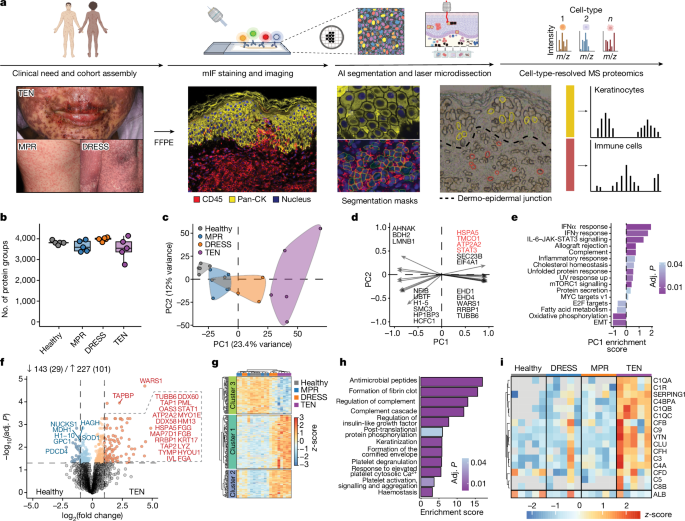2024-10-16 マックス・プランク研究所
<関連情報>
- https://www.mpg.de/23574790/1014-bioc-20241016-nordmann-mann-153945-x
- https://www.nature.com/articles/s41586-024-08061-0
空間プロテオミクスが致死的皮膚疾患の治療薬としてJAKiを同定 Spatial proteomics identifies JAKi as treatment for a lethal skin disease
Thierry M. Nordmann,Holly Anderton,Akito Hasegawa,Lisa Schweizer,Peng Zhang,Pia-Charlotte Stadler,Ankit Sinha,Andreas Metousis,Florian A. Rosenberger,Maximilian Zwiebel,Takashi K. Satoh,Florian Anzengruber,Maximilian T. Strauss,Maria C. Tanzer,Yuki Saito,Ting Gong,Marvin Thielert,Haruna Kimura,Natasha Silke,Edwin H. Rodriguez,Gaetana Restivo,Hong Ha Nguyen,Annette Gross,Laurence Feldmeyer,… Matthias Mann
Nature Published:16 October 2024
DOI:https://doi.org/10.1038/s41586-024-08061-0

Abstract
Toxic epidermal necrolysis (TEN) is a fatal drug-induced skin reaction triggered by common medications and is an emerging public health issue1,2,3. Patients with TEN undergo severe and sudden epidermal detachment caused by keratinocyte cell death. Although molecular mechanisms that drive keratinocyte cell death have been proposed, the main drivers remain unknown, and there is no effective therapy for TEN4,5,6. Here, to systematically map molecular changes that are associated with TEN and identify potential druggable targets, we utilized deep visual proteomics, which provides single-cell-based, cell-type-resolution proteomics7,8. We analysed formalin-fixed, paraffin-embedded archived skin tissue biopsies of three types of cutaneous drug reactions with varying severity and quantified more than 5,000 proteins in keratinocytes and skin-infiltrating immune cells. This revealed a marked enrichment of type I and type II interferon signatures in the immune cell and keratinocyte compartment of patients with TEN, as well as phosphorylated STAT1 activation. Targeted inhibition with the pan-JAK inhibitor tofacitinib in vitro reduced keratinocyte-directed cytotoxicity. In vivo oral administration of tofacitinib, baricitinib or the JAK1-specific inhibitors abrocitinib or upadacitinib ameliorated clinical and histological disease severity in two distinct mouse models of TEN. Crucially, treatment with JAK inhibitors (JAKi) was safe and associated with rapid cutaneous re-epithelialization and recovery in seven patients with TEN. This study uncovers the JAK/STAT and interferon signalling pathways as key pathogenic drivers of TEN and demonstrates the potential of targeted JAKi as a curative therapy.


